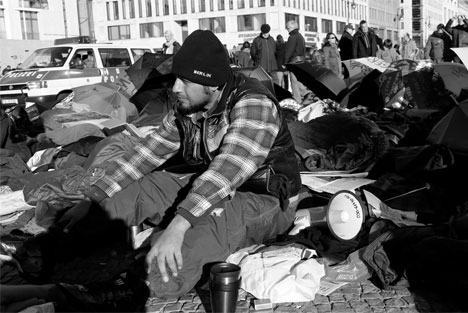
In the 1990s, Ukraine again became one of the world’s leading grain exporters after decades of Soviet agricultural mismanagement. It retains this status despite the major disruptions to the European grain market caused by the war.
There’s a new Europe-wide refugee movement taking shape. It has succeeded in making the problems refugees face a permanent topic of public debate, one that politicians can no longer ignore. And broad social solidarity with its demands is growing too, writes Martina Mauer.
The European Union’s approach to refugees is causing a humanitarian catastrophe: almost everyday, people die attempting to cross the tightly guarded external borders of Europe. According to estimates, lives lost since the 1990s total 19,000.
It is not uncommon for those who make it to Europe to be confronted with inhumane conditions. In the “reception centres” in Bulgaria, Hungary and Greece, asylum seekers are imprisoned for months on end and frequently mistreated. EU member states cart refugees here and there like so many postal packages, all in accordance with the Dublin Regulation. This stipulates that people can only apply for asylum in the country they first arrive in. In Germany too, asylum seekers continue to get stuck in collection centres and, in addition to not being allowed to move freely, are generally not allowed to work either.
People who have fled to Germany have already been protesting for two years against this policy of depriving them of their rights. Their protests have of late intensified to an unprecedented degree. Tactics range from many different kinds of civil disobedience, as well as countless rallies and demonstrations, to extreme actions like hunger and thirst strikes.

Hunger strike, Pariser Platz, Berlin, 28 October 2012. Photo: Michaela. Source: Flickr
In fact, refugees in Germany have always protested for their rights. However, what is new is the intensity, duration and European reach of the current protests, as well as the media attention and extent of the support that they have attracted.
It was Würzburg, Bavaria that provided the point of departure for the new refugee movement. In March 2012, a group of Iranians established a camp in the city centre and begun a hunger strike in protest against the inhumane conditions at their place of accommodation and their lack of prospects. Only a few weeks previously, these circumstances had driven the Iranian Mohammad Rahseparin to suicide.
The refugees’ actions laid the foundation stone for a movement that quickly spread. The refugee camp action was reproduced in urban centres throughout Germany as well as in neighbouring countries. Finally, over a period of several weeks beginning in October 2012, refugees walked to Berlin and established in Oranienplatz, Kreuzberg what was then the largest camp of its kind. The square became a European symbol of resistance and a refuge for those who had to flee their countries as well as a source of inspiration for new protests.
Shortly thereafter, refugees from various Bavarian collection centres established a camp at the Rindermarkt in central Munich and began a hunger and thirst strike. After police forcefully cleared their camp, they too departed for Berlin. In May 2013, a group of around 300 Africans in Hamburg going by the name of “Lampedusa in Hamburg” demanded the right to remain. The Lampedusa refugees who gathered at the same time in Berlin had been granted right of residence in Italy but, due to the economic crisis and lack of social services there, had no means of fulfilling the most basic of needs. Despite this, Germany made reference to Italy’s responsibility and refused the refugees access to both social services and the job market. The protesters’ demands ranged from the abolition of discriminatory regulations such as mandatory residence (Residenzpflicht) or the ban on employment, through the introduction of a humanitarian right to remain for certain groups or the recognition of specific reasons for seeking refuge, to completely reorienting German and European asylum policy. In addition, many activists demand freedom of movement, equal social rights and an end to global injustice.
It is perhaps the most important protest movement of recent years in Germany and is carried by people who find themselves in an extremely difficult situation. Almost all participants have an insecure residency status; deportation is a permanent threat. The Residenzpflicht hampers collective organization, since it deems leaving the premises of one’s allocated accommodation a punishable offence. In view of all of which, it is not surprising that the maintenance of the activists’ infrastructure and of their provisions occasionally lose out to the requirements of political protest, giving way to internal conflicts.
Nonetheless, activists have succeeded in carving out a place in public debate for the precarious living conditions of people in Germany who have been forced to flee their countries. This has forced the political sphere to take note. The concrete results of the protests, however, vary greatly.
The protests have met with the most sustained success in Bavaria. Despite the level of repression that the activists have had to deal with, the Bavarian government felt itself compelled, including on the basis of considerable media attention, to embark on the liberalization of Bavaria’s asylum policy long demanded by the opposition. In the spring of 2013 the then senator for social affairs Christine Haderthauer announced that Bavaria would be the first German state to introduce German courses for all asylum seekers. Six months later, her successor Emilia Müller let it be known that asylum seekers should receive money in the future, in lieu of controversial food packets.
In Hamburg, the SPD-led senate floundered in the face of Lampedusa in Hamburg’s increasingly strong public profile, explaining that the senate was not responsible for questions of European policy on refugees – matters in which it carried no influence. Members of the group Lampedusa in Hamburg were subjected to targeted police operations and supporters threatened with criminal prosecution for aiding illegal immigrants. The senate said it would not allow itself to be blackmailed from the street.
The Berlin borough of Friedrichshain-Kreuzberg under the leadership of the Greens did not, in the first place, stop the activists from establishing their camp on 6 October 2012 on
Oranienplatz and, two months later, occupying the site of a former school during the winter. One year later, Berlin’s senator for the interior Frank Henkel (CDU) gave the borough an ultimatum and threatened to have police clear the site. However, the mayor of Berlin Klaus Wowereit (SPD) overruled Henkel. Wowereit charged his senator for integration Dilek Kolat (SPD) with negotiating a consensual solution. But despite these developments, the solution that the senate’s strategy yielded could scarcely be described as consensual.
Rather, the senate succeeded in wearing the refugees down during talks that stretched out over weeks and playing off various groups and needs against one another. Ultimately, groups of residents dismantled the symbolic camp on Oranienplatz themselves, the opposition of other residents notwithstanding. An opponent of the clearance was always on hand in order to maintain a vigil. Ever since, the senate has elected to repress all such activities. In mid-May 2014, over 100 police dispersed a peaceful vigil of 11 refugees outside the Kaiser Wilhelm Memorial Church without the kind of consultations with politicians that had taken place previously.
In this instance, the authorities certainly had the leeway to enter into negotiations concerning at least some of the protesters’ demands. Residency laws offer numerous opportunities at the level of state government for granting refugees the right to remain (for example, section 23 para. 1 or section 25 para. 5 in German residence law, that is, the Aufenthaltsgesetz). Another option would be to press for a change in the law in the German Bundesrat – which is clearly the right address for protest, given the extent of Germany’s influence in the Council of the European Union.
In fact, groups of protesters repeatedly managed to negotiate with politicians, including on a federal level with the likes of the minister for integration Aydan Özoguz (SPD). However, discussions with state and federal politicians have merely led to loose agreements concerning accommodation and the legal approach taken in individual cases as well as to politicians promising to engage with the refugees’ political interests; and not to a collective right to remain or concrete changes in the law. As such, the central demands of the refugee movement remain unfulfilled.
At the beginning of the protests in spring 2012, it may have seemed as if the political landscape was undergoing slow transformation as far as refugees were concerned. Since 2010, several states have relaxed the Residenzpflicht. On 18 July 2012, as the constitutional court ruled that foreigners would receive the same minimum income as German citizens, it seemed as if a new era in asylum politics had begun.1
In contrast to the 1990s, today’s public debate is not shaped by cheap racist propaganda and misled anxieties over exceeding the capacity to receive refugees – even if initiatives on the Right continue to enjoy considerable success in mobilizing against new accommodation for refugees. Instead, there are initiatives in many places to welcome refugees. And not least thanks to the protests of refugees themselves, the conditions for the reception of refugees are being discussed nationwide. At first glance, the coalition agreement between the country’s ruling parties, the Christian Democratic Union of Germany (Christlich Demokratische Union Deutschlands or CDU) and the Social Democratic Party of Germany (Sozialdemokratische Partei Deutschlands or SDP), also contains some improvements: the introduction of an indefinite right to remain for those who have resided in Germany over many years without any legal residence status (the Geduldete), a reduction in the duration of the ban on employment and the further relaxation of the Residenzpflicht.
However, the coalition’s concessions have until now remained on paper. Moreover, even these have been dearly bought. The federal government’s first initiative in terms of migration policy was to announce its intention to designate Serbia, Bosnia-Herzegovina and Macedonia “safe countries of origin” in order to be able to speed up deportations of failed asylum seekers hailing from these countries. Furthermore, on 8 May, the ministry of the interior submitted a proposal for legislation to “newly define the right to remain and the termination of residence.” Heribert Prantl rightly described this in the German daily newspaper Süddeutschen Zeitung as “the harshest and shabbiest measure to have occurred to a German ministry in a long time”.2
In the proposal, the grounds for prohibiting residency are extended such that hardly anyone would profit for the planned regulation for a new right to remain. In addition, the law governing expulsion would be tightened and the imprisonment of asylum seekers made easier. The human rights organization Pro Asyl has already warned of a “gigantic programme of imprisonment”. No sign of any new departure. Rather, the proposal signals the dismantling of German asylum policy and a preference for deterrence and restriction.
On a European level, the liberalization of migration policy remains a non-runner – for all the concern that EU politicians showed at the deaths of hundreds of people off the coast of Lampedusa in October 2013. However, the European Parliament had already given the green light to the new European asylum system in June 2013 and thus missed the chance to effect a reversal in asylum policy – not least due to Germany’s obstructions.
Thus, not only does the inhumane asylum system based on the Dublin Regulation remain intact but the grounds for imprisoning asylum seekers have been extended considerably. In April this year, the powers of the European border agency Frontex were extended and an apparently legal basis created for the current practice of push-backs of refugee boats, a practice clearly in contravention of European law.
In spite of facing repression and numerous setbacks, the protests have ultimately had a positive outcome overall: the movement has led to a sustained politicization and an enormous self-empowerment among many refugees in Germany. The spirit of the protests has in the meantime spread among people in Germany who have been forced to flee their countries.
The activists refuse to become objects of the arbitrary actions of the authorities and discriminatory laws. They organize themselves and self-confidently transgress regulations applying to non-natives so as to impact on the public sphere, make visible discrimination and exert pressure on state agencies to negotiate.
As long as European and German asylum policy fails to undergo fundamental change, new places and forms of protest will emerge. In May 2014, around a hundred activists from the German refugee movement embarked on a march from Strasburg to Brussels with a view to taking their protest to the European level. A new, unique project of Europe-wide refugee protests has begun to grow.
In view of these developments, politicians cannot simply look away. It is not sufficient to relax discriminating regulations such as the Residenzpflicht, the ban on employment and the law on asylum seeker benefits (Asylbewerberleistungsgesetz); rather these need to be completely abolished. Germany and the European Union must relinquish their restrictive migration policies, make allowances for forced migration and allow asylum seekers to decide for themselves which EU member state they wish to live and work in. In order to effect such a change in policy, it is not only further, stronger protests that required. What is also necessary is broad social solidarity with the demands of the refugee movement.
BVerfG, 1 BvL 10/10, 18 July 2012
Heribert Prantl, "Perfidie in Paragrafenform", Süddeutsche Zeitung, 9 May 2014, www.sueddeutsche.de/politik/gesetzentwurf-zur-asylpolitik-perfidie-in-paragrafenform-1.1955012
Published 18 July 2014
Original in German
Translated by
Ben Tendler
First published by Blätter für deutsche und internationale Politik 7/2014 (German version); Eurozine (English version)
Contributed by Blätter für deutsche und internationale Politik © Martina Mauer / Eurozine
PDF/PRINTSubscribe to know what’s worth thinking about.

In the 1990s, Ukraine again became one of the world’s leading grain exporters after decades of Soviet agricultural mismanagement. It retains this status despite the major disruptions to the European grain market caused by the war.

Radical reform is needed to make Europe’s agricultural sector financially sustainable and environmentally resilient. Yet Europe’s biggest farming lobby, together with the EPP, opposes any policy inimical to the interests of large landowners.